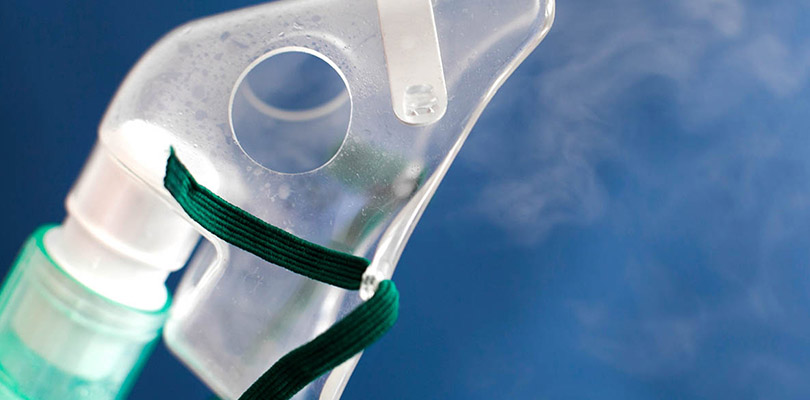Photo Credit: FlairImages / istockphoto.com
COPD Headaches
COPD may be a respiratory disease, but like so many chronic illnesses, it touches on every system in the body. Emphysema and bronchitis symptoms manifest in the lungs — coughing, breathlessness, chest tightness and pain are common complaints. However, these conditions can have other far-reaching effects that can complicate things, including throbbing headaches.
COPD headaches are incredibly common, and often not very serious. However, when they occur alongside COPD, they deserve closer attention. Fortunately, there are ways to relieve the discomfort of COPD headaches and sidestep complications if you improve your COPD management in a few specific ways.
How Lung Damage Can Lead to Headaches
Inflammation and tissue damage in the airways interfere with how you use the air you breathe, which can change your blood composition. As your lungs lose the ability to efficiently take in oxygen and push out carbon dioxide, two processes occur:
- Hypoxia (not enough oxygen in your blood)
- Hypercapnia (too much carbon dioxide in your blood)
These two conditions combine to slow down cell function, alter your system of blood vessels, and ultimately cause the throbbing pain of a COPD headache. The load of carbon dioxide in your blood prompts the blood vessels in your brain to widen (dilate) in an effort to take in more oxygen. As these surface blood vessels dilate, they put pressure on the surrounding tissue and nerves, which results in a headache.
Since mucus and inflammation commonly build up in the airways while you sleep, COPD patients tend to inhale less oxygen and expel less carbon dioxide during the night. This means the blood vessel dilation happens well before morning, which explains why you may wake up with a throbbing headache.
In some cases, using supplemental oxygen during the night can lead to too much oxygen in your blood, and strangely, this can also bring on a headache.
The Dangers of Headaches with COPD
Morning headaches can be a sign that your COPD is worsening. Waking with more headaches than usual can mean that your lungs are losing more function as your COPD progresses to an advanced stage. If you’ve suddenly started to experience headaches, it might signal an oncoming exacerbation.
In either case, COPD headaches can put you at risk for serious complications. Each COPD exacerbation you experience increases the likelihood of permanent loss of lung function, long-term hospitalization, and death. There are also some specific conditions associated with COPD headaches, such as:
Sleep Apnea
A condition that interrupts the natural breathing rhythm, sleep apnea can cause you to stop breathing for several seconds at a time, resulting in low blood oxygen levels. It occurs in about 15% of COPD patients, and can lead to more hospitalizations for exacerbations.
High Blood Pressure
Since headaches are a sign of low oxygen, you might also notice other physical problems that come with hypoxia, especially in the heart. Low blood oxygen can speed up your heart rate and cause your blood pressure to increase, both of which will tax your cardiovascular system.
Due to different breathing patterns, COPD and abdominal bloating are often related. Here are some tips to help reduce uncomfortable bloating.
Improve your Breathing to Reduce Your Headaches
If you want to get rid of your headaches, you need to get to the root of the problem: your blood oxygen levels. How you choose to treat your COPD during the day and during the night can make a big difference in the amount of airflow in and out of your lungs.
Quit Smoking
First and foremost, give up the habit for good. You’ve heard it from your doctor and read it in dozens of places, but it can’t be overstated: smoking is the single worst thing you can do for your COPD. The sooner you can quit, the sooner your lungs can regain some function. Even if your tissue damage is permanent, you will notice improvements in your breathing very shortly after you butt out once and for all.
Oxygen Therapy
Naturally, more oxygen flowing directly to your lungs will improve your chances of absorbing it into your bloodstream. Nocturnal oxygen therapy is a common treatment for morning headaches and sleep problems in those with COPD, and it’s relatively easy to use: a thin tube will connect your airways to the tank, using a face mask, nasal tube, or windpipe tube to deliver the oxygen.
Sleep Aids
If you suspect sleep apnea, have your doctor organize a sleep study to test your nighttime breathing. If you are losing oxygen at night, you should begin sleep apnea treatment right away. Continuous nasal airway pressure devices (which come in the form of a mask that you wear throughout the night) are very helpful for many people, and minimally invasive.
Propping yourself up on a couple of extra pillows can also help you breathe better during the night. By keeping your chest upright, mucus is less likely to settle throughout your airways, and there is less chance that your breathing will become obstructed.
Regular Exercise
You may not feel like being active every day, but exercise is the quickest and most effective avenue to stronger lungs and easier breathing. The more efficient your lungs and heart can work when they’re at rest, the less labored your breathing will be. Studies have also shown that exercise leads to significant improvement in sleep among those with chronic lung diseases.
Tend to Your Pain
Treating the pain of the headache is an important part of your COPD management, since it affects your quality of life. First, consult with your doctor about your headaches to be sure they’re related to your COPD. Headaches can come in different forms and from different conditions, so it’s important to consider all aspects instead of simply assuming they’re COPD-related.
Although pain relievers can’t solve the core issue of abnormal blood oxygen and carbon dioxide levels, they can help you stay alert and mobile as you do your best to improve your situation with smart lifestyle changes and targeted medications for better lung function.







